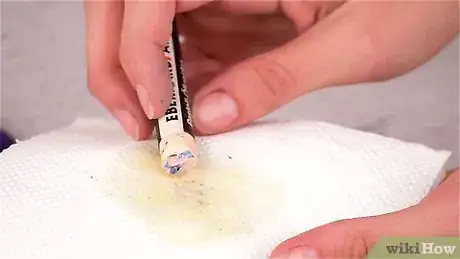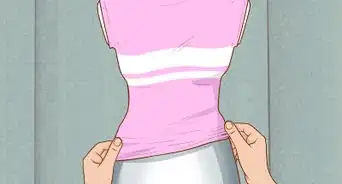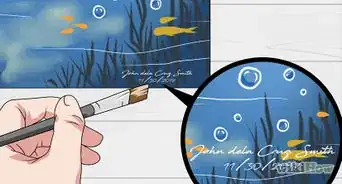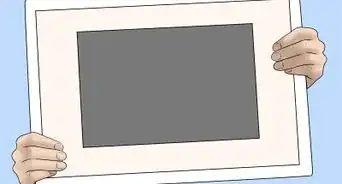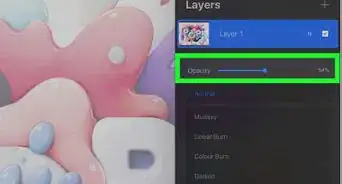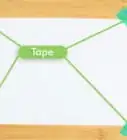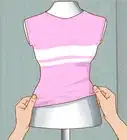This article was co-authored by wikiHow staff writer, Jessica Gibson. Jessica Gibson is a Writer and Editor who's been with wikiHow since 2014. After completing a year of art studies at the Emily Carr University in Vancouver, she graduated from Columbia College with a BA in History. Jessica also completed an MA in History from The University of Oregon in 2013.
There are 8 references cited in this article, which can be found at the bottom of the page.
The wikiHow Video Team also followed the article's instructions and verified that they work.
This article has been viewed 22,183 times.
Learn more...
If you've been working with oil pastels for a while, you know that they can turn dingy and discolored over time. Painting with dirty oil pastels isn't just a nuisance—it can really mess up your project! Prevent streaks of accidental color by cleaning off your pastels before you use them. We've also got you covered if your oil pastels leave stains behind and the good news is, you've probably got all the cleaning supplies at home already.
Steps
Cleaning the Pastels
-
1Dip a paper towel in oil and rub it on a pastel to lift dirty spots. If your pastel just has a few spots where other colors have bumped against it, take a clean cloth or paper towel and dip it into a little olive oil. Then, rub it against the dirty area until you see just the original color. That's it! Since it can be time-consuming to do this for a lot of oil pastels, it works best for quick touch-ups.[1]
- Don't forget to wipe the wrappers too!
-
2Drag the sides of a pastel against rough paper for a quick clean. If you're in the middle of a project, it can be hard to stop and deep clean all of your pastels. In a pinch, just take your dirty pastel and rub it against the thickest paper you can find. Keep turning and rubbing the pastel until you see the pure color of the pastel.[2]
- It's really important to use a clean piece of scrap paper. If you rub your pastel against paper that already has pigment on it, the pastel will just get dirtier!
Advertisement -
3Scrape off stubborn pigment with a painting knife. Sometimes, pastels can be really tricky to clean, especially if it's been a few years since you've cleaned them. If you've tried rubbing, scraping, or shaking the dirty color off without any luck, don't give up! Take a paint knife and carefully scrape it against the dirty pastel to lift off the old, dirty pigment.[3]
- Don't have a paint knife? Try a small kitchen knife instead.
-
4Shake dirty pastels with rice or cornmeal to clean a lot of pastels at once. While it might seem counterintuitive, you can actually clean a handful of pastels in 1 container. Fill a storage container half full with dried rice or cornmeal and put all of your dirty pastels into it. Cover the pastels with more rice or cornmeal and seal the container. Shake it for 10 seconds so the rice or cornmeal wears away the dirt. Then, just take the clean pastels out and set them on a clean cloth.[4]
- The rice or cornmeal stops the pastels from bumping into each other. Instead, they cushion the pastels while they wear away the outer layer of each pastel.
- If you have a lot of pastels, hang onto the container of rice or cornmeal. Store it in your studio so you can clean your pastels at a moment's notice.
-
5Store your pastels by color family to prevent them from getting really dirty. Sorting pastels by similar shades keeps them cleaner in the long run. For example, you won't see blue marks on the side of a yellow pastel since you're not storing them side by side. Find a storage system you like, such as flat trays or shallow containers with lids, and try organizing the pastels by these groups:[5]
- Violet and pink
- Red and orange
- Yellow and cream
- Green
- Blue
- Black and gray
- White
Removing Oil Pastel Stains
-
1Run a cycle with rags if your dryer has oil pastel stains. Oh, no—you go to take clothes out of the dryer only to find that you washed an oil pastel in the load! Don't worry. Remove the clothes and wipe down the inside of your dryer with paper towels. Then, rub a melamine cleaning sponge over the surface and put a bunch of clean, dry rags into the machine. Run a standard cycle and that should lift traces of stains from your machine.[6]
- If the pigment was really dark, you might have to repeat this process to get rid of the stain.
-
2Rub WD-40 and dish detergent into fabric if you have an oil stain on your clothes. Working with oil pastels is messy! If you've accidentally gotten it on your clothes, lay the item on paper towels and spray the stain with WD-40. Leave it alone for a few minutes before you flip it over and spray the other side of the stain. Rub a squirt of dish soap into the stain and then wash the clothes in hot water with your usual laundry detergent.[7]
- It's always a good idea to test a small, inconspicuous area on the clothes before you spray WD-40 on the stain. Although you can try it on most fabrics, don't use it on clothes that have to be washed on a cool, gentle cycle.
- If you still see a stain on the clothes, treat it with your favorite stain remover and wash it again.
-
3Lift oil pastel stains from fabric or carpet using rubbing alcohol. Try to work as fast as you can so the stain doesn't set. Pick out as much oil pastel from the fabric or carpet as you can and rub ice cubes over the area to harden the oil pastel that's left. Then, scrape off more of the pastel. To lift the stain that's left, dip a cotton ball in rubbing alcohol and press it into the stain until it's gone.[8]
- Got a really stubborn oil stain? Don't panic! Rub a few drops of liquid dish soap into the stain and rinse it out with a damp cloth. You might have to do this a few times for a deep stain.
-
4Rub toothpaste onto a wall if you've got oil pastel stains on it. If you have artistic kids, you may find their latest project on your wall. Fortunately, it's pretty easy to remove an oil pastel stain from painted walls. Just squeeze toothpaste over the stain and rub the wall with a clean cloth. Keep rubbing until the stain is gone![9]
- If you don't want your wall to smell minty fresh when you finish, take a clean damp cloth and wipe it over the wall to remove traces of the toothpaste.
-
5Spray all-purpose cleaner if you have a stain on the table or a vinyl floor. You might be surprised at how easy it is to lift oil pastel stains from your kitchen floor. Spritz the stain with an all-purpose cleaner and wipe it up with a paper towel. This should do the trick, but if you still see a slight stain, rub a soapy sponge over the stain and wipe it up with a damp cloth.[10]
- If you're cleaning a hardwood surface instead, skip the all-purpose cleaner and just use a soapy cloth.
Things You'll Need
Cleaning the Pastels
- Dry rice or cornmeal
- Airtight storage container
- Clean cloth or paper towel
- Olive oil
- Coarse paper
- Oil pastels
Removing Oil Pastel Stains
- Clean cloths
- Melamine cleaning sponge
- Toothpaste
- WD-40
- All-purpose cleaner
- Liquid dish soap
References
- ↑ http://magazine.greatart.co.uk/2019/10/11/how-can-i-clean-my-oil-pastels/
- ↑ https://steemit.com/diy/@yashny/diy-cleaning-old-oil-pastels-or-how-to-clean-oil-pastels-or-re-use-oil-pastels
- ↑ http://magazine.greatart.co.uk/2019/10/11/how-can-i-clean-my-oil-pastels/
- ↑ https://youtu.be/h2w5AzFuhXM?t=179
- ↑ https://youtu.be/Ngrf3oCOdgU?t=79
- ↑ https://mbroug2.wixsite.com/kirkersville-art/tips
- ↑ http://www.crayola.com.au/support/stain-tips/oil-pastels-crayola-and-portfolioreg-series/oil-pastels-crayola-and-portfolioreg-series-on-fabricsfresh-stainsheatset-stainsmelted/
- ↑ https://mbroug2.wixsite.com/kirkersville-art/tips
- ↑ https://youtu.be/uOVJpcAZ6OE?t=19
